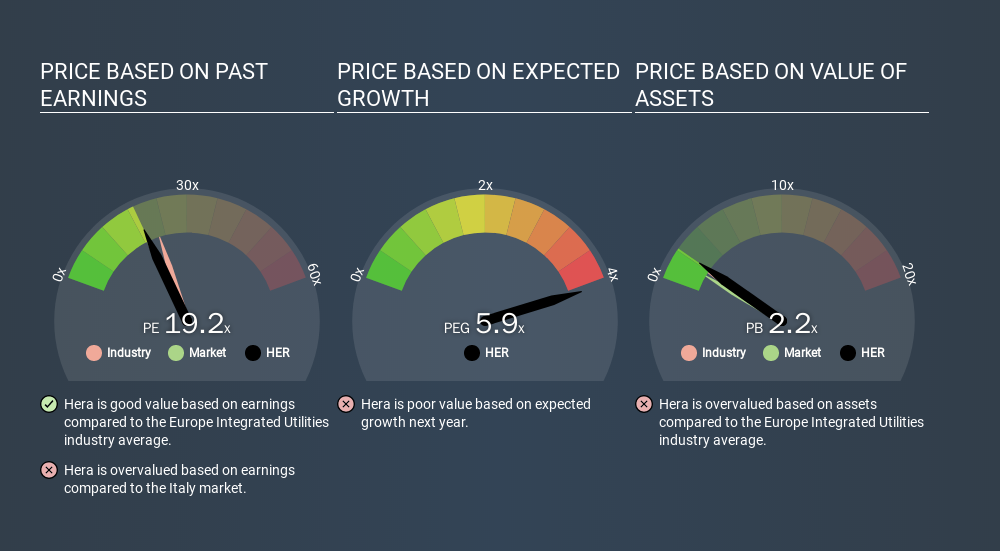The goal of this article is to teach you how to use price to earnings ratios (P/E ratios). We'll show how you can use Hera S.p.A.'s (BIT:HER) P/E ratio to inform your assessment of the investment opportunity. What is Hera's P/E ratio? Well, based on the last twelve months it is 19.20. That corresponds to an earnings yield of approximately 5.2%.
See our latest analysis for Hera
How Do You Calculate A P/E Ratio?
The formula for price to earnings is:
Price to Earnings Ratio = Share Price ÷ Earnings per Share (EPS)
Or for Hera:
P/E of 19.20 = €3.97 ÷ €0.21 (Based on the trailing twelve months to September 2019.)
Is A High P/E Ratio Good?
A higher P/E ratio means that buyers have to pay a higher price for each €1 the company has earned over the last year. That isn't a good or a bad thing on its own, but a high P/E means that buyers have a higher opinion of the business's prospects, relative to stocks with a lower P/E.
Does Hera Have A Relatively High Or Low P/E For Its Industry?
The P/E ratio indicates whether the market has higher or lower expectations of a company. The image below shows that Hera has a lower P/E than the average (22.3) P/E for companies in the integrated utilities industry.

This suggests that market participants think Hera will underperform other companies in its industry. While current expectations are low, the stock could be undervalued if the situation is better than the market assumes. You should delve deeper. I like to check if company insiders have been buying or selling.
How Growth Rates Impact P/E Ratios
Earnings growth rates have a big influence on P/E ratios. Earnings growth means that in the future the 'E' will be higher. And in that case, the P/E ratio itself will drop rather quickly. And as that P/E ratio drops, the company will look cheap, unless its share price increases.
Hera saw earnings per share improve by -9.7% last year. And earnings per share have improved by 15% annually, over the last five years.
Remember: P/E Ratios Don't Consider The Balance Sheet
Don't forget that the P/E ratio considers market capitalization. In other words, it does not consider any debt or cash that the company may have on the balance sheet. Hypothetically, a company could reduce its future P/E ratio by spending its cash (or taking on debt) to achieve higher earnings.
Such spending might be good or bad, overall, but the key point here is that you need to look at debt to understand the P/E ratio in context.
Is Debt Impacting Hera's P/E?
Net debt is 48% of Hera's market cap. While it's worth keeping this in mind, it isn't a worry.
The Verdict On Hera's P/E Ratio
Hera has a P/E of 19.2. That's around the same as the average in the IT market, which is 18.5. With modest debt and some recent earnings growth, it seems likely the market expects a steady performance going forward.
When the market is wrong about a stock, it gives savvy investors an opportunity. If the reality for a company is better than it expects, you can make money by buying and holding for the long term. So this free report on the analyst consensus forecasts could help you make a master move on this stock.
But note: Hera may not be the best stock to buy. So take a peek at this free list of interesting companies with strong recent earnings growth (and a P/E ratio below 20).
If you spot an error that warrants correction, please contact the editor at editorial-team@simplywallst.com. This article by Simply Wall St is general in nature. It does not constitute a recommendation to buy or sell any stock, and does not take account of your objectives, or your financial situation. Simply Wall St has no position in the stocks mentioned.
We aim to bring you long-term focused research analysis driven by fundamental data. Note that our analysis may not factor in the latest price-sensitive company announcements or qualitative material. Thank you for reading.
About BIT:HER
Hera
A multi-utility company, engages in the waste management, water services, and energy businesses in Italy.
Solid track record established dividend payer.
Similar Companies
Market Insights
Community Narratives



